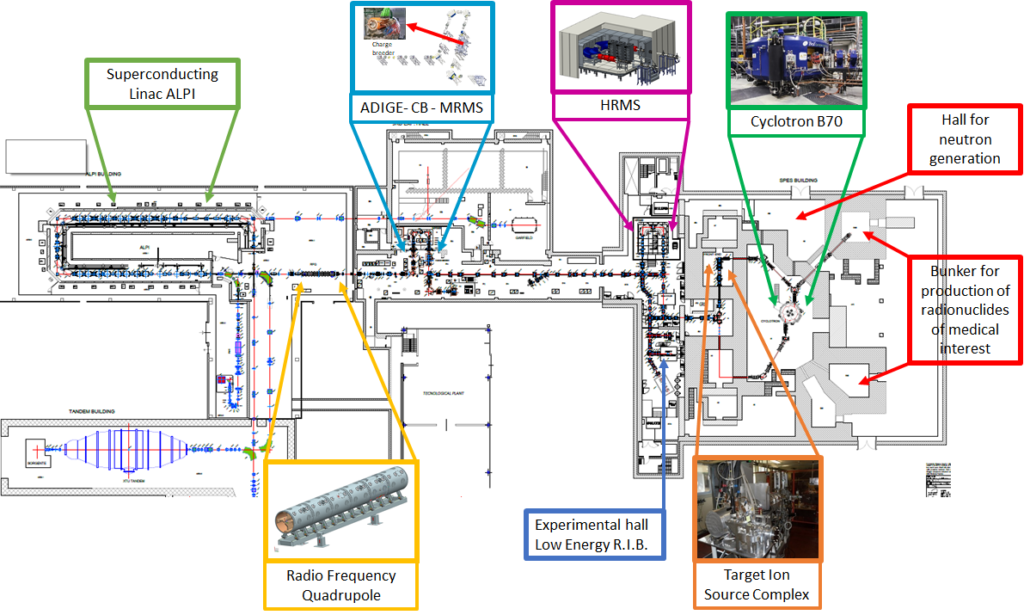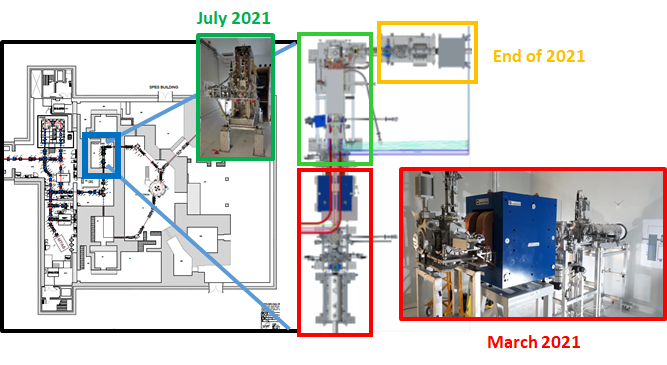The SPES project (Selective Production of Exotic Species) aims at the realisation of an accelerator facility for research in the fields of Fundamental Physics and Interdisciplinary Physics:
-Fundamental Physics:
Nuclear Physics, in particular investigations on nuclear matter in extreme conditions
Nuclear Astrophysics, in particular research on the stellar evolution
-Interdisciplinary Physics:
use of radionuclides of medical interest for imaging and oncological therapy
generation of neutron sources for material studies, nuclear technologies and medical applications
Research in the field of Fundamental Physics will be accomplished thanks to the availability of radioactive ion beams, while research in the field of Interdisciplinary Physics will be based on the production of radionuclides of medical interest and on the generation of neutron sources.
For the production of radioactive ion beams for fundamental physics, of radionuclides of medical interest and of neutron sources, an accelerator facility has been designed according to the conceptual scheme in the lay-out displayed below, where it is possible to locate the following main components:
-The Cyclotron B70, an accelerator able to produce protons with energy 35-70 MeV and maximum intensity of 750 μA. Accelerated protons form the primary beam, which is delivered on target systems of several types for production of radioactive ion beams for fundamental physics, of radionuclides of medical interest and of neutron sources
-The Target Ion Source Complex for production and ionisation of radioactive ion beams for fundamental physics
-The experimental hall for experiments with non reaccelerated radioactive ion beams (Low Energy R.I.B.)
-The High Resolution Mass Spectrometer HRMS for mass separation of radioactive ion beams
-The ADIGE injector, which includes the Medium Resolution Mass Spectrometer MRMS and the Charge Breeder CB to increase the charge state of radioactive ion beams
-The RFQ (Radio Frequency Quadrupole) for pre-acceleration of radioactive ion beams
-The superconductive linear accelerator ALPI for acceleration of radioactive ion beams
-The bunkers where the target systems will be installed for production of radionuclides of medical interest
-The hall where the system for generation of neutron sources will be installed

The SPES project is divided into the following 4 phases:
-SPES-alpha: production and delivery to the target of Cyclotron proton beams
-SPES-beta: production (protons -> Target Ion Source Complex) and acceleration (ALPI) of radioactive ion beams with the ISOL (Isotope Separation On Line) technique
-SPES-gamma: production of radionuclides of medical interest (protons -> target)
-SPES-delta: generation of neutron sources (protons -> target)
At present (September 2021) the infrastructures and the safety system of the SPES building are in progress, towards the completion phase. They are mandatory for the issue of the Fire Prevention Certificate and for the license related to the radiological risk.
The Cyclotron was installed and tested in 2017, therefore it is ready to be operated after the license will be issued. In parallel, all of the other components, previously described, are being completed.
An important milestone during the year 2021 is the installation of the Target Ion Source Complex for production of radioactive ion beams. Two out of three installation phases have already been completed, the third phase will be finished by the end of 2021. See the installation scheme reported below.
Another important milestone in 2021 is the assembling of the first of six modules of the RFQ. The other five modules will complete the RFQ realisation in the first months of 2022.
For more details on the SPES project, please visit the project web site
